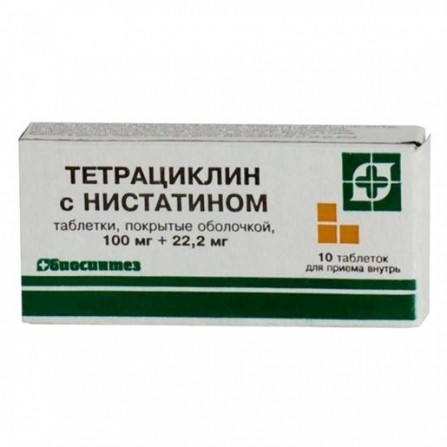Tetracycline with nystatin pills coated 100000 units N10
Condition: New product
1000 Items
Rating:
Be the first to write a review!

More info
Active ingredients
Nystatin + Tetracycline
Release form
Pills
Composition
Tablets, coated 1 tab. tetracycline 100 mg nystatin 22.2 mg.
Pharmacological effect
Combined antibacterial agent. Tetracycline is a bacteriostatic tetracycline antibiotic. Active against gram-positive (Staphylococcus spp, including penicillinase;.. Streptococcus spp, Streptococcus pneumoniae; Haemophilus influenzae, Listeria spp, Bacillus anthracis.) And gram-negative bacteria (Neisseria gonorrhoeae, Bordetella pertussis, Escherichia coli, Enterobacter spp. , Klebsiella spp., Salmonella spp., Shigella spp.), As well as Rickettsia spp., Chlamydia spp., Mycoplasma spp., Treponema spp. Resistant: Pseudomonas aeruginosa, Proteus spp., Serratia spp., Most strains of Bacteroides spp. and fungi, small viruses. Nystatin is a polyene fungicidal antibiotic highly active against yeast-like fungi of the genus Candida spp.
Indications
Infectious diseases caused by susceptible microflora: - pneumonia - bronchitis - tracheitis - pleural empyema - cholecystitis - pyelonephritis - intestinal infections - whooping cough - endocarditis - endometritis - prostatitis - syphilis - gonorrhea - brucellosis - rickettsiosis - purulent tattosperm - anesthesia - anemia - anemia - anemia - anemia - gonorrhea - brucellosis - rickettsiosis - purulent infections of soft tissue - anesthesia - anesthesia - anemia - a syphilis - gonorrhea - brucellosis - rickettsiosis - purulent infections of soft tissue - anesthesia - anesthesia - anesthesia - gonorrhea - brucellosis - rickettsiosis - purulent infections of the human patients - Ize - angeral - Ize - angeral - Ize - anemia - gonorrhea - brucellosis - rickettsiosis - pus infections - blepharitis - tonsillitis - otitis media - pharyngitis - furunculosis - infected eczema - rash - acne - folliculitis - prevention of postoperative infections.
Contraindications
- hypersensitivity - pregnancy (III trimester) - lactation period - children's age (up to 8 years) - liver failure - leukopenia - peptic ulcer and duodenal ulcer.
Use during pregnancy and lactation
Contraindications: pregnancy (III trimester); lactation period.
Dosage and administration
Inside, drinking plenty of liquid, adults - 250 mg 4 times / day, if necessary - 2 g / day. Children over 8 years old - 25 mg / kg 4 times / day.
Side effects
Decreased appetite, vomiting, diarrhea, nausea, glossitis, esophagitis, gastritis, ulceration of the stomach and duodenum, dysphagia; photosensitization, allergic reactions (maculopapular rash, skin flushing, angioedema, anaphylactoid reactions, drug-induced lupus erythematosus); hemolytic anemia, thrombocytopenia, neutropenia, superinfection (including fungal); intestinal dysbiosis; hypovitaminosis B; increased activity of hepatic transaminases, hypercreatininemia, azotemia, hyperbilirubinemia.
Interaction with other drugs
In connection with the suppression of intestinal microflora reduces the prothrombin index (requires dose adjustment of indirect anticoagulants).Reduces the effectiveness of bactericidal antibiotics that violate the synthesis of the cell wall (penicillins, cephalosporins). Antacids containing calcium, aluminum and / or magnesium, iron preparations reduce absorption. Chymotrypsin increases the concentration and duration of circulation.
special instructions
Due to the possible development of photosensitivity, it is necessary to limit insolation. With prolonged use, periodic monitoring of the function of the kidneys, liver, blood-forming organs is necessary. It may mask the manifestations of syphilis, and therefore, with the possibility of mixed infection, it is necessary to conduct a monthly serological analysis for 4 months. Reception during the period of development of teeth can cause an irreversible change in their color. To prevent hypovitaminosis, you should prescribe vitamins B and K, brewer's yeast.


